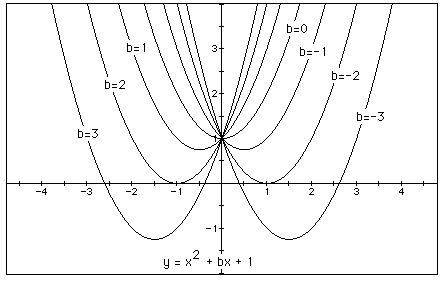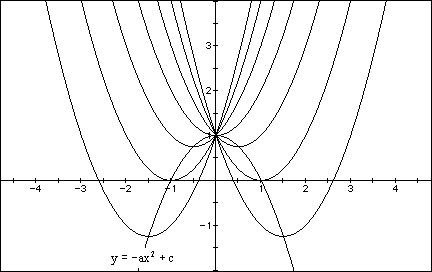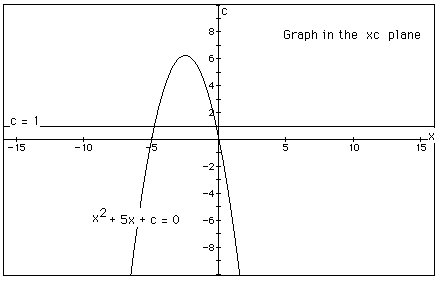


It has now become a rather standard exercise,
with available technology, to construct graphs to consider the
equation

and to overlay several graphs of

for different values of a, b, or c as the
other
two are held constant. From these graphs discussion of the patterns
for the roots (or where the graph touches the x-axis) of

can be followed. For example, if we set

for b = -3, -2, -1, 0, 1, 2, 3, and overlay
the graphs, the following picture is obtained.

We can discuss the "movement" of a parabola as b is changed. The parabola always passes through the same point on the y-axis ( the point (0,1) with this equation). The graph's behavior on the x-axis has three different trends, which translate into zero, one, or two roots for the equation.
1. For b < -2 the parabola will intersect the x-axis in two points with positive x values (i.e. the original equation will have two real roots, both positive). For b > 2, the parabola intersects the x-axis twice to show two negative real roots for each b.
2. For b = -2, the parabola is tangent to the x-axis and so the original equation has one real and positive root at the point of tangency. Similarly for b = 2 the parabola is tangent to the x-axis (one real negative root) and
3. For -2 < b < 2, the parabola does not intersect the x-axis -- the original equation has no real roots.
There will never be more than two roots because the equation's highest term is squared. The number of roots an equation has is less than or equal to the degree to which it is raised. A squared equation is a parabola, which can only cross the x-axis a maximum of 2 times due to its shape.
Now consider the locus of the vertices of the
set of parabolas
graphed from
 .
. ,
, .
. .
. .
. .
.
Consider again the equation

Now graph this relation in the xb plane. We get the following graph.

If we take any particular value of b, say b = 3, and overlay this
equation on the graph we add a line parallel to the x-axis. If it
intersects the curve in the xb plane the intersection points correspond
to the roots of the original equation for that value of b. We have the
following graph.

For each value of b we select, we get a horizontal line. This
horizontal line will intersect the graph twice, once, or not at all,
giving us two roots, one root, or no roots.
1. When b > 2 (see previous figure) we get two negative real roots, and when b < -2 we get two positive real roots. In this case each horizontal line crosses the graphed curve at two places.
2. When b = 2 we get one real negative root, and when b = -2 we get
one real positive root. In this case each horizontal line crosses the
curve at one point.
3. When -2 < b < 2 we do not get any real roots.
Now consider the case when c = - 1(red curves) rather than + 1(green
curves).


 .
.In the following example the equationis considered.

If the equation is graphed in the xc plane, it is easy to see that the curve will be a parabola. For each value of c considered, its graph will be a line crossing the parabola in 0, 1, or 2 points -- the intersections being at the roots of the original equation at that value of c. In the graph, the graph of c = 1 is shown. The equation

will have two negative roots -- approximately -0.21 and -4.79.

For each value of c we select, we get a horizontal line. This
horizontal
line will intersect the parabola twice, once, or not at all, giving us
two
roots, one root, or no roots.
1. When c < 6.25 (see previous figure) we get two real roots, both negative for 0 < c < 6.25, one negative and one 0 when c = 0 and one negative and one positive when c < 0. In this case the horizontal line crosses the parabola at two places.
2. When b = 6.25 we get one real negative root. In this case the
horizontal line crosses the
curve at one point.

Assignment 2
Return to main Page
Assignment 4